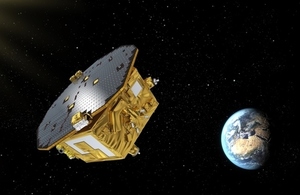Freefall achieved on LISA Pathfinder
Gravitational wave mission achieves next milestone.

Artist's impression of LISA Pathfinder. Credit: ESA–C.Carreau.
On Monday, the 2 cubes housed in the core of Europe’s LISA Pathfinder were left to move under the effect of gravity alone – another milestone towards demonstrating technologies to observe gravitational waves from space.
It has been an intense couple of months for the UK-led spacecraft. After launch on 3 December and performing six burns to raise the orbit, it finally reached its work site – 1.5 million km from Earth towards the Sun – in January, and the team of engineers and scientists started to switch on and test its systems.
One of the most delicate operations entailed releasing the two test masses from the mechanisms that kept them in place during ground handling, launch and cruise.
First, the eight locking ‘fingers’ pressing on the corners of the identical gold–platinum cubes were retracted on 3 February. The cubes were then being held in position only by two rods, softly pushing on opposite faces.
These rods were retracted from the first test mass on 15 February, and from the second on the following day, leaving the cubes floating freely several millimetres from the walls of their housings.
The successful release of the two cubes, floating in space 1.5 million km away, left the team members thrilled and delighted.
Over the following days, minute electrostatic forces were applied to manoeuvre the cubes and make them track the spacecraft’s motion through space as it is slightly disturbed by external forces such as the pressure from sunlight.
This enabled the team to run further tests on the instruments, including the system used to measure the electrical charge of each cube and the procedures used to monitor their position and orientation.
Then the team aligned the two cubes with the laser beams that link them, and checked that the laser measurements agreed with those from the electrostatic sensors.
After verifying that everything was working as planned, the intensity of the electrostatic forces was gradually reduced until none was being applied along the sensitive axes of the masses. This resulted in a brief test of drag-free motion, on 19 February.
Finally, on 22 February, the team tackled the greatest challenge: setting the two cubes completely free, letting them move under the effect of gravity alone and actively manoeuvring the spacecraft around them.
To do this, LISA Pathfinder measures the position and orientation of each cube, and corrects its movement by firing microthrusters to keep it centred on one cube.
This is a historic achievement: we are demonstrating the most precise freefall that has ever been obtained in space
says Paul McNamara, LISA Pathfinder project scientist.
The UK’s involvement in LISA Pathfinder’s technology demonstration payload and the operational phase of the mission is funded by the UK Space Agency and was formerly funded by the Science and Technology Facilities Council (STFC). Airbus Defence and Space is the prime contractor for the mission, having built the spacecraft, as well as being the LISA Test Package (LTP) architect, on behalf of ESA and the participating Member States.
SciSys UK Ltd developed the satellite’s on-board software and UK scientists from the University of Birmingham, the University of Glasgow and Imperial College London designed and built elements of the innovative and complex LTP. STFC RAL Space was involved in several technology development projects in the early stages of the mission in 2001.
Read more about LISA Pathfinder.